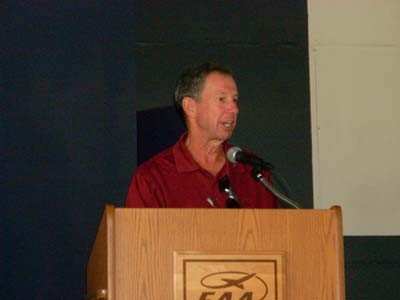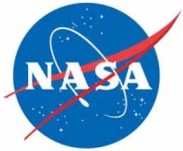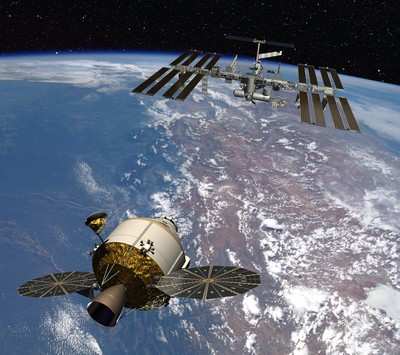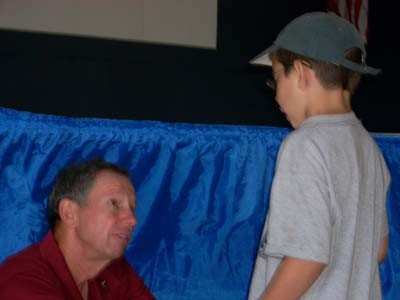"This IS Rocket Science -- If We Knew How To Do It, It Wouldn't
Be Exploration"
by ANN Correspondent Maxine Scheer
Attendees at AirVenture 2008 had the opportunity Tuesday
afternoon to ask questions of NASA Administrator Dr. Michael
Griffin. He acknowledged the agency's 2008 celebration of their
50th anniversary and indicated to the audience that he'd rather
discuss their questions about the future than expound upon the
past. Somewhat surprisingly, many of the audience questions focused
on NASA's plans for space, versus issues associated with civil
aviation.

Griffin spoke to potential scientific breakthroughs that could
be achieved by moving forward with the establishment of a new space
vehicle capable of extending the range beyond that of the Space
Shuttle, which is limited to low earth orbit. "If NASA is able to
maintain a consistent vision, in the next 15 years the US could
have a base on the moon, rotating staff [ ] like they do now in the
Antarctic."
He emphasized the importance of scientific study in areas such
as molecular and cell biology in the solar radiation conditions of
deep space as examples of what could be done over the next 20+
years. Other examples he used were research into the prospects of
using water as a shield to overcome solar radiation problems on
long voyages or using the resources of the moon to sustain life,
such as heating the moon's surface to extract oxygen.
 A common thread throughout the hour-plus discussion was the
logic, or lack thereof, of discontinuing the Space Shuttle until a
replacement vehicle was in operation. According to NASA's website,
the current plan includes phasing out the Space Shuttle in 2010 and
using Russian Soyuz and Progress spacecraft to shuttle astronauts
and supplies to the International Space Station (ISS) until a US
replacement is developed. "The US and its partners have invested
$100 billion in the [ISS]," said Griffin, "so it does seem
short-sighted to not spend the $3 billion a year to maintain the
Shuttle. " Directing his comments to the children in the audience,
"Sometimes Washington does silly things."
A common thread throughout the hour-plus discussion was the
logic, or lack thereof, of discontinuing the Space Shuttle until a
replacement vehicle was in operation. According to NASA's website,
the current plan includes phasing out the Space Shuttle in 2010 and
using Russian Soyuz and Progress spacecraft to shuttle astronauts
and supplies to the International Space Station (ISS) until a US
replacement is developed. "The US and its partners have invested
$100 billion in the [ISS]," said Griffin, "so it does seem
short-sighted to not spend the $3 billion a year to maintain the
Shuttle. " Directing his comments to the children in the audience,
"Sometimes Washington does silly things."
Referring to past mistakes, "We made a terrible decision when
the Apollo program was cancelled. We invested $25 billion in the
Apollo program, $21 billion to build it, and only $4 billion to use
it. We need to believe in our long-term policy."
There was a sizable contingent of elementary aged children
patiently seated in the front row that came up to the podium to
discuss their questions, face to face. Their very practical
questions included: "Why is Pluto no longer a planet? "If we send
things to Mars that are useful only for 90 days, aren't we
littering?" "Why does higher gravity make things rounder?" "How
does going to Mars [positively] affect the global community?
Dr. Griffin responded to each of the questions directly and
referenced the work of Steven Hawking; he spoke on the theory of
how the US controls the future of humanity because of the country's
capabilities in space travel. "Ten major extinction events on earth
have been recorded. Life on earth is precarious - this alone
justifies space exploration. The US has an opportunity by
undertaking a leadership role that would capture the world-wide
excitement of space exploration."
One of the children asked the question,"Who in 15 years could be
an astronaut?" He described roles beyond pilots such as Civil
Engineers, Astronomers, and Life Scientists and commented that the
boy who asked the question would be just the right age to be a
candidate, after finishing his graduate education of course.

A few audience questions centered on the vibration issues
associated with the Constellation launch. Dr. Griffin expressed the
opinion that much of the concerns were "media induced" and that
NASA was close to fixing the problem. "I hope this is the worst
problem [we face]. The prevailing attitude is that [any] obstacle
with a new initiative is a disaster.
"This is rocket science," added Griffin. "If we knew [exactly]
how to do it, it wouldn't be exploration."
When asked what would he do if "wishes were free" and NASA's
budget were doubled (the equivalent of the inflation-adjusted
program for Apollo), the Administrator's response was as follows:
1) [We] wouldn't rely on another country and would develop a new
system in parallel to continuing to use the Space Shuttle; 2) Begin
working on vehicle systems sooner; and 3) Do more advanced
research, the "blue sky stuff."
Griffin noted that the last wish was the most difficult. "The
political environment has changed. If the [NASA] administration
can't guarantee an outcome, then [blue sky research] is difficult
to justify. This is where the advancements in science are made and
where there needs to be acceptance that there will be some
[disappointments]."

In celebration of NASA's 50th anniversary, there is a special
NASA exhibit at EAA's AirVenture Museum. Because of all the Public
Relations engagements this year, NASA was not able to fund the NASA
exhibit at AirVenture, but he speculated it was likely to return in
2009.
 NTSB Final Report: Cessna 177B
NTSB Final Report: Cessna 177B ANN's Daily Aero-Term (05.08.25): Final Approach Fix
ANN's Daily Aero-Term (05.08.25): Final Approach Fix Aero-News: Quote of the Day (05.08.25)
Aero-News: Quote of the Day (05.08.25) ANN's Daily Aero-Term (05.09.25): Estimated (EST)
ANN's Daily Aero-Term (05.09.25): Estimated (EST) ANN's Daily Aero-Linx (05.09.25)
ANN's Daily Aero-Linx (05.09.25)






